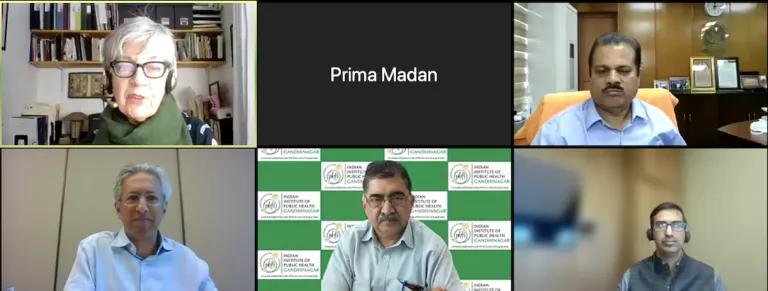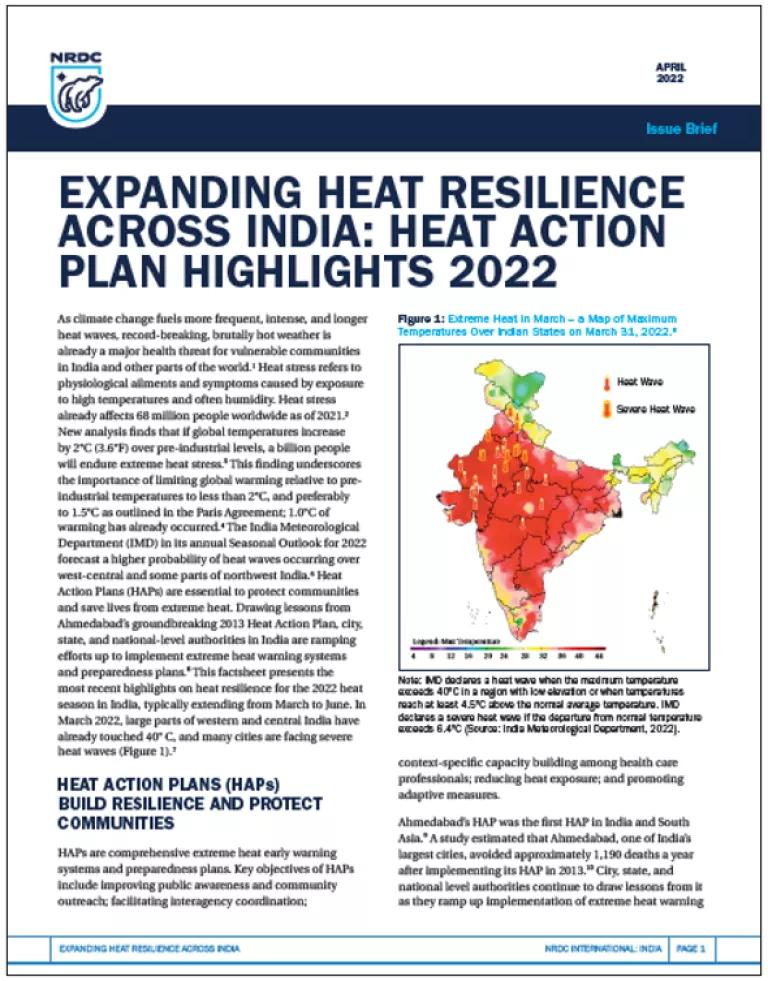As Excessive Heat Blankets India, Adaptation Is Imperative
Experts outline adaptation priorities to keep people safe from dangerous heat.

Indian cities, including Mumbai, are taking action to reduce health risks from extreme heat.
Chetan Bisariya
In a clear call for action, the Intergovernmental Panel on Climate Change Report on Climate Change Impacts, Adaptation, and Vulnerability sounded the alarm that adaptation to intensifying climate risks is an urgent imperative, especially in parts of the Global South where millions of people are imperiled by searing temperatures and lack of broad access to affordable, efficient air conditioning to keep cool. Echoing this message on a day when conditions across India registered much warmer than average and the high temperature in Delhi soared to 40°C (104°F), a panel of experts at an event co-hosted by NRDC and Climate Trends drew attention to the monumental health risks posed by climate change-driven extreme heat. Panelists also offered actionable solutions for expanding heat adaptation across the country and in other heatwave-prone parts of the world.
Extreme heat is not merely an inconvenience: it can be dangerous to public health, and even deadly. That’s why coordinated actions that strengthen heat resilience—across public and private spheres, in historically hot areas as well as more recently heat-vulnerable—are so crucial. As climate change-fueled extreme heat continues to worsen in India, stakeholders across government, civil society, and academic institutions are prioritizing health-protective adaptation responses—and by doing so, providing instructive examples for other heat-prone regions around the world.
Experts at the event discussed solutions and priority areas for interventions to strengthen preparedness and response to extreme in India, particularly focused on the most vulnerable.

Adaptation Experts Offer Proven Solutions
- Early warning systems and coordinated responses to protect vulnerable populations save lives. In Ahmedabad, for example, the city’s pioneering heat action plan has helped the city to prevent more than 1,100 deaths each year since it launched in 2013. This ground-breaking work can inform how cities worldwide can adapt to extreme heat in a more equitable and durable way. Manish Bapna, President and CEO of NRDC noted: “Heat kills--but it doesn’t have to. Over the past decade, NRDC and partners in India have been working with communities on the front lines to promote more inclusive health preparedness and build climate resilience. Together, we’ve developed a model Heat Action Plan that hundreds of cities in India have now embraced and adapted.”
- Dr. Dileep Mavalankar of the Public Health Foundation of India and Indian Institute of Public Health-Gandhinagar (IIPH-G) drew attention to heat action planning and the need to implement “a strong public health policy response” to extreme heat events that includes “robust early warning systems, effective outreach strategies to improve community awareness, and tailored measures to reach vulnerable populations.” As climate change worsens extreme heat risks in India, Dr. Mavalankar underlined “work to further strengthen these plans and adapt them to local needs” as a priority.
- Dr. Mrutyunjay Mohapatra, Director General of the India Meteorological Department (IMD) highlighted actions to make heat forecasts useful for society, noting: “IMD is committed to provide improved and upgraded early-warning heat forecasts that help hundreds of cities take protective action and create locally-tailored measures to reduce the harms of extreme heat.”
- Bijalben Brahmbhatt, Director of the Mahila Housing Trust (MHT) spoke about MHT’s work to protect heat-vulnerable people, including low-income communities and populations living in informal settlements. “MHT is working with these communities to install cool roofs that help households to reduce health risks from extreme heat,” she noted.
Publication Highlights India’s Efforts to Strengthen Heat Resilience
At the close of the event, NRDC and partners released a publication of new analysis of India’s heat adaptation efforts at the national, state, and city levels.

This issue brief is the latest in a series of annual heat resilience updates summarized by NRDC, and includes updates on new approaches to address the intensifying extreme heat threat beyond Ahmedabad, such as:
- Andhra Pradesh, in the southeast, continues to step up efforts to combat extreme heat by issuing heat-health warnings (with particular emphasis on vulnerable groups) and raising awareness among the public and health workers. The state has launched a heat awareness campaign to inform citizens to avoid peak heat times between 11 a.m. and 5 p.m. and to take extra precautions for pregnant women in rural areas.
- Maharashtra, in the west, developed a statewide heat action plan in 2017. Five major cities in Maharashtra, including Mumbai, are implementing Climate Action Plans to adapt, mitigate, and build resilience to climate change. Mumbai’s climate plan proposes several ways to deal with rising heat: increasing vegetated green cover, setting up warning systems and cooling centers in vulnerable areas, and adopting new building design policies to reduce heat retention. Mumbai also recently announced that it is aiming to reach net-zero emissions by 2050, making it the first city in South Asia to set such a timeline and 20 years ahead of India’s national target.
- Odisha, in the far east, continues its pioneering disaster preparedness work in India, from cyclones to heatwaves. Building on its 2015 HAP, the Odisha State Disaster Management Authority (OSDMA) tackles heatwaves through an early warning system that considers both temperature and humidity levels to issue heat alerts. Odisha developed a website and a mobile phone app that provides heat alerts and helps users identify, via maps, heat shelters and drinking water sources along highways. To build capacity among healthcare workers, Odisha has set up dedicated sections in hospitals to provide treatment for heat-related illness and increases staffing during heat alerts.
The issue brief also outlines key common elements of heat action plans across the country and provides updates on recent research exploring the development of city-level heat vulnerability indices to better target adaptation interventions.




